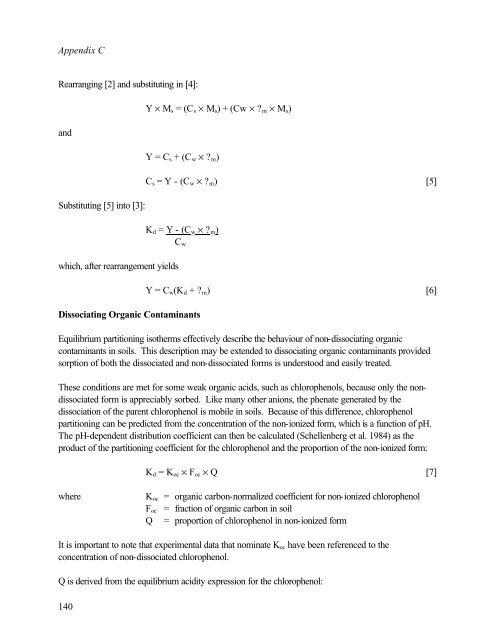Protocol for the Derivation of Environmental and Human ... - CCME
Protocol for the Derivation of Environmental and Human ... - CCME
Protocol for the Derivation of Environmental and Human ... - CCME
You also want an ePaper? Increase the reach of your titles
YUMPU automatically turns print PDFs into web optimized ePapers that Google loves.
Appendix C<br />
Rearranging [2] <strong>and</strong> substituting in [4]:<br />
<strong>and</strong><br />
Substituting [5] into [3]:<br />
which, after rearrangement yields<br />
Y × M s = (C s × M s ) + (Cw × ? m × M s )<br />
Y = C s + (C w × ? m )<br />
C s = Y - (C w × ? m ) [5]<br />
K d = Y - (C w × ? m )<br />
C w<br />
Dissociating Organic Contaminants<br />
Y = C w (K d + ? m ) [6]<br />
Equilibrium partitioning iso<strong>the</strong>rms effectively describe <strong>the</strong> behaviour <strong>of</strong> non-dissociating organic<br />
contaminants in soils. This description may be extended to dissociating organic contaminants provided<br />
sorption <strong>of</strong> both <strong>the</strong> dissociated <strong>and</strong> non-dissociated <strong>for</strong>ms is understood <strong>and</strong> easily treated.<br />
These conditions are met <strong>for</strong> some weak organic acids, such as chlorophenols, because only <strong>the</strong> nondissociated<br />
<strong>for</strong>m is appreciably sorbed. Like many o<strong>the</strong>r anions, <strong>the</strong> phenate generated by <strong>the</strong><br />
dissociation <strong>of</strong> <strong>the</strong> parent chlorophenol is mobile in soils. Because <strong>of</strong> this difference, chlorophenol<br />
partitioning can be predicted from <strong>the</strong> concentration <strong>of</strong> <strong>the</strong> non-ionized <strong>for</strong>m, which is a function <strong>of</strong> pH.<br />
The pH-dependent distribution coefficient can <strong>the</strong>n be calculated (Schellenberg et al. 1984) as <strong>the</strong><br />
product <strong>of</strong> <strong>the</strong> partitioning coefficient <strong>for</strong> <strong>the</strong> chlorophenol <strong>and</strong> <strong>the</strong> proportion <strong>of</strong> <strong>the</strong> non-ionized <strong>for</strong>m:<br />
K d = K oc × F oc × Q [7]<br />
where<br />
K oc = organic carbon-normalized coefficient <strong>for</strong> non-ionized chlorophenol<br />
F oc = fraction <strong>of</strong> organic carbon in soil<br />
Q = proportion <strong>of</strong> chlorophenol in non-ionized <strong>for</strong>m<br />
It is important to note that experimental data that nominate K oc have been referenced to <strong>the</strong><br />
concentration <strong>of</strong> non-dissociated chlorophenol.<br />
Q is derived from <strong>the</strong> equilibrium acidity expression <strong>for</strong> <strong>the</strong> chlorophenol:<br />
140
















